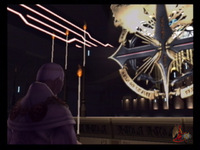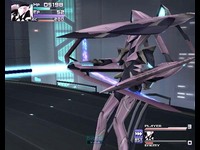|
|

|
PLATFORM
|
PS2
|
BATTLE SYSTEM
|

|
INTERACTION
|

|
ORIGINALITY
|

|
STORY
|

|
MUSIC & SOUND
|

|
VISUALS
|

|
CHALLENGE
|
Moderate
|
COMPLETION TIME
|
20-40 Hours
|
|
OVERALL

|
+ Quick and immersive combat
+ Actual music while exploring - and it's good
+ Story may not be without holes, but it's unique
- Many voices are different, and not better
- Mech combat isn't interesting
- Optional content is mostly dull fetch quests
|
Click here for scoring definitions
|
|
|
Most series have at least one black sheep that is the recipient of fans' ire. For the Xenosaga series, that role has definitely fallen to Xenosaga Episode 2: Jenseits von Gut und Boese, and not without some justifications. Among other things; the combat's challenge is erratic, much of what made Episode 1 unique has been altered, the story is a long way from flawless, and voice actor changes accompany many of their redesigns in appearance. This turns Episode 2 into something of a mess, but picking through the mess is surprisingly enticing.
Xenosaga's narrative turns the focus away from Shion Uzuki in this installment, giving Jr. the most development of the protagonists. His close relationship with MOMO means that she gets plenty of attention too, starting with an attempted kidnapping by the mysterious force that seeks the Y-Data buried within her mind. After some action sequences that fuse Minority Report and The Matrix Reloaded, the protagonists attempt to access the Y-Data for themselves. After that, things start to get bizarre.
Episode 2's plot has plentiful issues, and apparently most of them will simply be forgotten in Episode 3. Just some of them are: weapons that consume entire planets in their activation, a large dungeon placed between two black holes, the personality of a dead man lying in the subconscious of someone in the present, and an organization that supposedly has existed since before the time of Christ without ever being referenced. Tight storytelling is clearly not the specialty of Monolith Soft, but one thing the developer cannot be accused of is lacking ambition. It may be alternately ponderous and inscrutable, but Xenosaga's story is not played safe. Being overly ambitious is a rare quality in the RPG world, and though the game does not succeed at everything it attempts, the effort is appreciated.
 This guy is patriarch of an organization over 6000 years old. Were the Freemasons renamed?
This guy is patriarch of an organization over 6000 years old. Were the Freemasons renamed?
|
|
Episode 2's combat is related to that of Episode 1, but the pace has been increased to a more energetic level. Playing the game as a standard turn-based battler is likely to make it extremely difficult, as two systems are in place to subvert the usual methods. First is something called Stock, which allows characters to forgo the current turn in order to launch multiple attacks on the same move in future. Boosting is the second stratagem, by which the turn order is rearranged to let the recipient of a Boost act immediately after the current actor. The rules governing how Boost is accumulated are somewhat fuzzy, but even gazing concernedly at the ability's gauge to see if it can currently be activated injects quite a bit of energy into the standard turn-based bashing. Some of the difficulty in combat comes from enemies being able to use their own Boosts to interrupt player tactics, though the rest comes from how hard they can hit.
Most of this kinetic behavior goes out the window when it comes to battles in the mandatory mechanical mounts, E.S.. The robots gain experience separately from the protagonists, and the Ether (aka magic) abilities of most characters disappear when they pilot these mechs. Boosting and Stacking are still available steps when fighting with them, but the opportunity for long combination moves is almost absent. Sadly, the robot battles tend to be rather boring affairs, especially when the options for healing during them are limited enough to damp down the difficulty so that players aren't enraged.
The skill system of Episode 2 is simplified from its predecessor, simply pooling points that characters can use in a single section of the menu. The streamlining removes the ability to empower the statistics and attacks of characters, but the available options are nevertheless plentiful. The processes within the menu generally require a bit of familiarization, but are efficient to access and use after that.
Plenty of the skills in Episode 2 are initially unavailable, and unlocking them necessitates finding keys. Some of these keys are located in the dungeons of the game, but far more require participating in a Global Samaritan campaign that constitutes most of the optional content. While a few hidden bosses can be found on Global Samaritan quests, almost all of them demand that the player participate in lengthy fetch quests, which are less exciting than those found in many other games. Unless one reloads a save from finishing the game to access content extra content that has appeared, the Global Samaritan work represents the only side quest material, and most of it is very dull, though it serves to add many hours to a game that can be completed in about twenty-five normally.
 It's a good thing this mech can dodge pretty well, since taking hits isn't its style.
It's a good thing this mech can dodge pretty well, since taking hits isn't its style.
|
|
Replacing Yasunori Mitsuda as the composer for the series, Yuki Kajiura's music does one thing that Episode 1's did not: it consistently accompanies the action. Sparse sound effects are no longer the usual complement to the action, which would make it easy to overlook any deficiencies of the score, but Kajiura's energetic techno style is quite catchy on its own merits. The voice acting is not up to the same level: even if the matter of most actors having been replaced between games is set aside, the monotone readings most of the new people give are hard to accept. Big emotions are not a strong point of the performers, which makes it unfortunate that they are required to attempt the delivery of such.
The visuals of Episode 2 are overall brighter than those of Episode 1, which makes navigating environments considerably easier. Otherwise, the look of the game is about on par with its predecessor, representing a solid effort for the PlayStation 2 that doesn't push the system's capabilities. Jaw-dropping moments are not derived from the graphics of the game.
Xenosaga Episode 2 is a curious game. While certainly problematic, the resounding disdain with which it is regarded seems odd, considering that it is hardly a horror. Enough works to make this required playing for anyone interested in Xenosaga, though using it as an introduction to the series is a very bad idea when it assumes familiarity with the first title. Frustrating it can certainly be, but Episode 2 is not atrocious.
Review Archives
|









